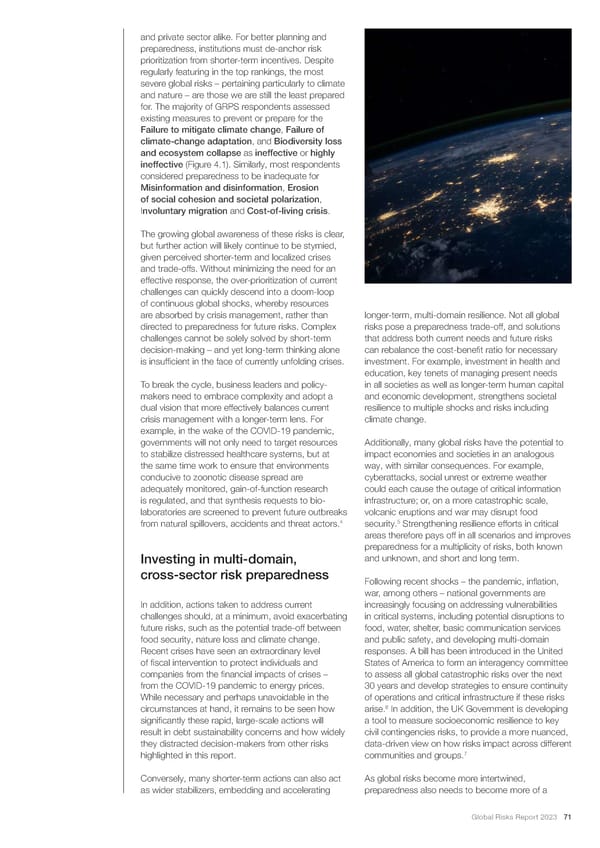and private sector alike. For better planning and preparedness, institutions must de-anchor risk prioritization from shorter-term incentives. Despite regularly featuring in the top rankings, the most severe global risks – pertaining particularly to climate and nature – are those we are still the least prepared for. The majority of GRPS respondents assessed existing measures to prevent or prepare for the Failure to mitigate climate change, Failure of climate-change adaptation, and Biodiversity loss and ecosystem collapse as ineffective or highly ineffective (Figure 4.1). Similarly, most respondents considered preparedness to be inadequate for Misinformation and disinformation, Erosion of social cohesion and societal polarization, Involuntary migration and Cost-of-living crisis. The growing global awareness of these risks is clear, but further action will likely continue to be stymied, given perceived shorter-term and localized crises and trade-offs. Without minimizing the need for an effective response, the over-prioritization of current challenges can quickly descend into a doom-loop of continuous global shocks, whereby resources are absorbed by crisis management, rather than longer-term, multi-domain resilience. Not all global directed to preparedness for future risks. Complex risks pose a preparedness trade-off, and solutions challenges cannot be solely solved by short-term that address both current needs and future risks decision-making – and yet long-term thinking alone can rebalance the cost-bene昀椀t ratio for necessary is insuf昀椀cient in the face of currently unfolding crises. investment. For example, investment in health and education, key tenets of managing present needs To break the cycle, business leaders and policy- in all societies as well as longer-term human capital makers need to embrace complexity and adopt a and economic development, strengthens societal dual vision that more effectively balances current resilience to multiple shocks and risks including crisis management with a longer-term lens. For climate change. example, in the wake of the COVID-19 pandemic, governments will not only need to target resources Additionally, many global risks have the potential to to stabilize distressed healthcare systems, but at impact economies and societies in an analogous the same time work to ensure that environments way, with similar consequences. For example, conducive to zoonotic disease spread are cyberattacks, social unrest or extreme weather adequately monitored, gain-of-function research could each cause the outage of critical information is regulated, and that synthesis requests to bio- infrastructure; or, on a more catastrophic scale, laboratories are screened to prevent future outbreaks volcanic eruptions and war may disrupt food 4 5 from natural spillovers, accidents and threat actors. security. Strengthening resilience efforts in critical areas therefore pays off in all scenarios and improves preparedness for a multiplicity of risks, both known Investing in multi-domain, and unknown, and short and long term. cross-sector risk preparedness Following recent shocks – the pandemic, in昀氀ation, war, among others – national governments are In addition, actions taken to address current increasingly focusing on addressing vulnerabilities challenges should, at a minimum, avoid exacerbating in critical systems, including potential disruptions to future risks, such as the potential trade-off between food, water, shelter, basic communication services food security, nature loss and climate change. and public safety, and developing multi-domain Recent crises have seen an extraordinary level responses. A bill has been introduced in the United of 昀椀scal intervention to protect individuals and States of America to form an interagency committee companies from the 昀椀nancial impacts of crises – to assess all global catastrophic risks over the next from the COVID-19 pandemic to energy prices. 30 years and develop strategies to ensure continuity While necessary and perhaps unavoidable in the of operations and critical infrastructure if these risks 6 circumstances at hand, it remains to be seen how arise. In addition, the UK Government is developing signi昀椀cantly these rapid, large-scale actions will a tool to measure socioeconomic resilience to key result in debt sustainability concerns and how widely civil contingencies risks, to provide a more nuanced, they distracted decision-makers from other risks data-driven view on how risks impact across different highlighted in this report. communities and groups.7 Conversely, many shorter-term actions can also act As global risks become more intertwined, as wider stabilizers, embedding and accelerating preparedness also needs to become more of a Global Risks Report 2023 71
 Global Risks Report 2023 Page 70 Page 72
Global Risks Report 2023 Page 70 Page 72